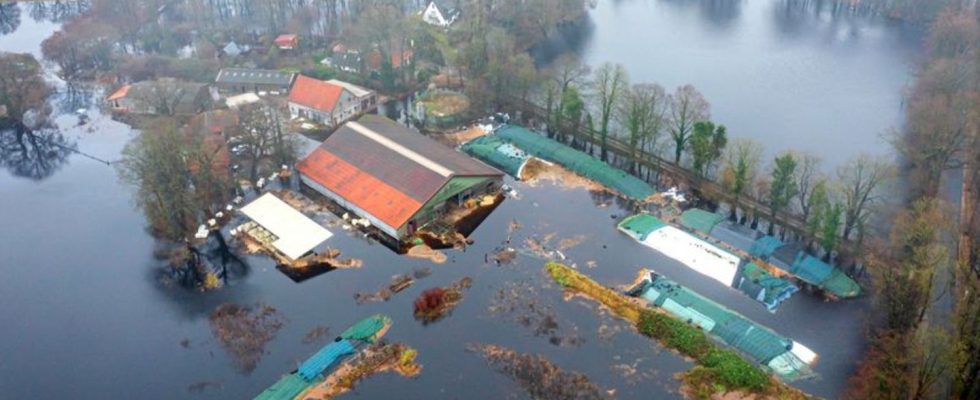storm
Constant rain continues – major concern in flood areas
A farm in the Timmersloh district of Bremen is under water. photo
© Sina Schuldt/dpa
Emergency services have been on the move non-stop in the areas affected by flooding for days. In some places they were able to take a breather over the turn of the year. Now it’s raining again – and a lot.
Lower Saxony, parts of North Rhine-Westphalia, the south of Saxony-Anhalt and the north of Thuringia are still particularly affected. According to the weather service, heavy amounts of rain can be expected from Lower Saxony to the Black Forest as well as in the eastern and southeastern low mountain ranges until Thursday. Within 30 to 60 hours, meteorologists expect 30 to 50 liters per square meter, in mountainous areas up to 120 liters.
Dikes are being strengthened in many places
In many places in Germany, emergency services are preparing for the possible effects of new rainfall. In the municipality of Lilienthal near Bremen, sodden dikes were stabilized with sandbags. Almost 100 people there are currently unable to go into their houses or apartments. To protect houses, a barrier with extra-large sandbags has also been erected as close as possible to the dike. Such a bag weighs up to 1.3 tons, said a spokeswoman for the municipality. A mobile dike around 800 meters long was built elsewhere.
The city of Oldenburg also protects itself against flooding with a mobile dike. The city announced on Tuesday that the dike, around two kilometers long on Sandkruger Strasse, was ready. In acute cases, any remaining gaps should be closed using sandbags, among other things. It is a precautionary measure in case the Hunte dike can no longer withstand the masses of water.
According to a spokesman, a federal police helicopter was used several times and transported around 36 tons of sand by Tuesday. Due to the situation in Lower Saxony, Bundeswehr helicopters are also on standby. Brandenburg’s Prime Minister Dietmar Woidke (SPD) offered his state’s help.
At the same time, Lower Saxony can rely on support from France. A first part of an approximately 1.2 kilometer long mobile dike system from the neighboring country was still expected, as a spokesman for the Ministry of the Interior announced. Lower Saxony’s Interior Minister Daniela Behrens (SPD) spoke on the NDR-Info broadcaster of well under 2,000 people who were brought to safety because of the flood. Given the situation, this is not very much.
In the Serengeti Park in Hodenhagen, Lower Saxony, the critical flood situation has meanwhile eased. The water receded again, as a spokeswoman for the amusement park north of Hanover said. The main access road to the park is passable again. However, there is still no central power supply and generators are used. “Some animals are still in makeshift shelters,” said the spokeswoman – such as blue wildebeest and meerkats.
No all-clear yet in NRW
In North Rhine-Westphalia, the Environment Ministry in Düsseldorf did not give the all-clear on Tuesday either. The flood situation continued to ease over the New Year’s Eve weekend. “However, we are already seeing that the current rainfall is causing the first small bodies of water to rise again,” said a ministry spokesman for the German Press Agency. Whether this situation worsens further depends on the rainfall that falls on Tuesday and Wednesday.
In the south of Saxony-Anhalt, the district administrator of the Mansfeld-Südharz district, André Schröder (CDU), spoke of a very serious situation. Hundreds of emergency services are on duty along the Helme dikes to reinforce, secure and build the dikes, it was said. On the Thuringian side, a decision should be made at the Helme in the Kyffhäuser district as to whether a dike breach at Mönchpfiffel-Nikolausrieth should be deepened in order to drain water onto fields.
The dams in the Harz are still very full. However, it is possible to reduce the water release in order to relieve the pressure on the lower reaches of the rivers, said the Harz waterworks. “The dams have recovered due to the higher taxes in the last few days and can hold more water again,” said the commercial director of the waterworks, Lars Schmidt. This would be important for rivers in Lower Saxony, among other things.
In Brandenburg, the Elbe near Wittenberge in the Prignitz slightly exceeded the six-meter mark on Tuesday afternoon. According to the city, it is expected that the highest water level has been reached and the situation will ease. Alert level 2 still applies, which means, among other things, that the dikes are constantly monitored and preparations are made for flood protection.
In other regions of Germany people look at the sky with fear. In the north of Bavaria, the rains increased the risk of flooding again. According to the flood intelligence service on Tuesday, large parts of Upper Franconia are affected.
DRK sees deficits in preparing for disasters
Meanwhile, the German Red Cross (DRK) is pushing for better preparation for such crises. “We need more and better equipment for disasters in Germany,” said DRK President Gerda Hasselfeldt to the “Rheinische Post”. “The deficits are glaring, especially when it comes to material equipment.” After the flood disaster in the Ahr Valley in 2021, the politically responsible people’s awareness of civil protection increased. “There’s not much left of it now.”

